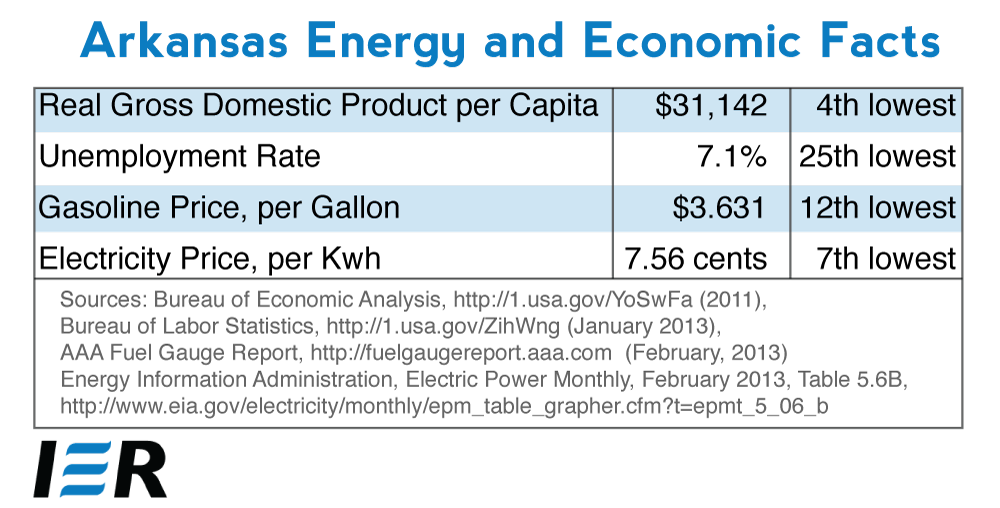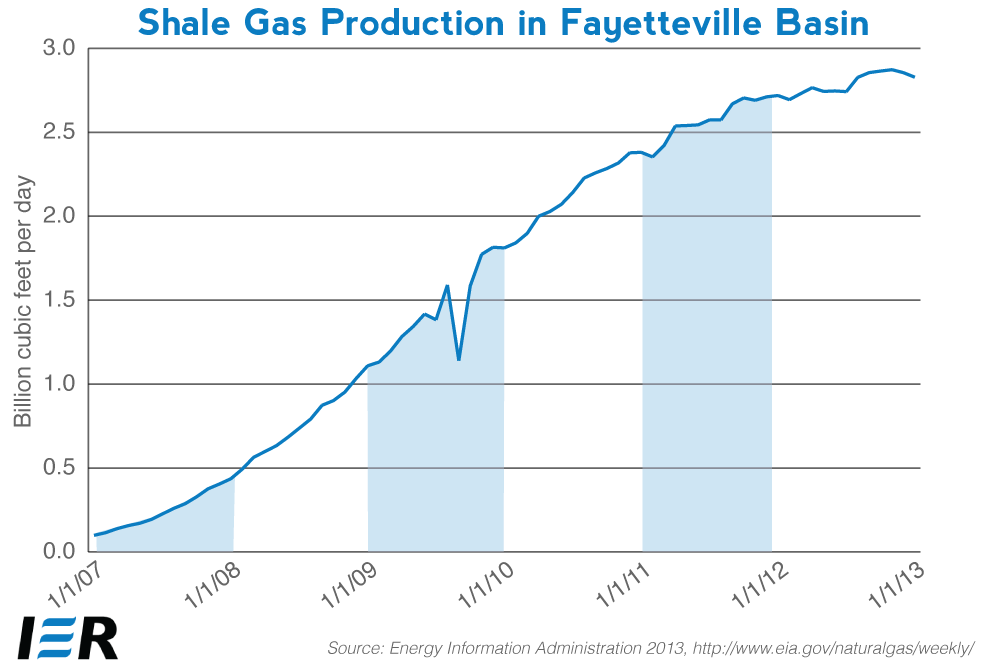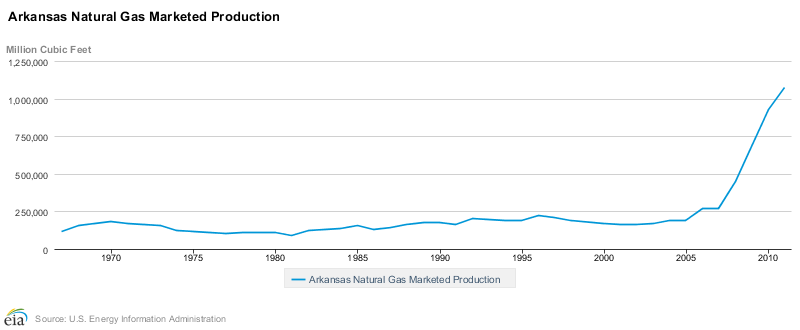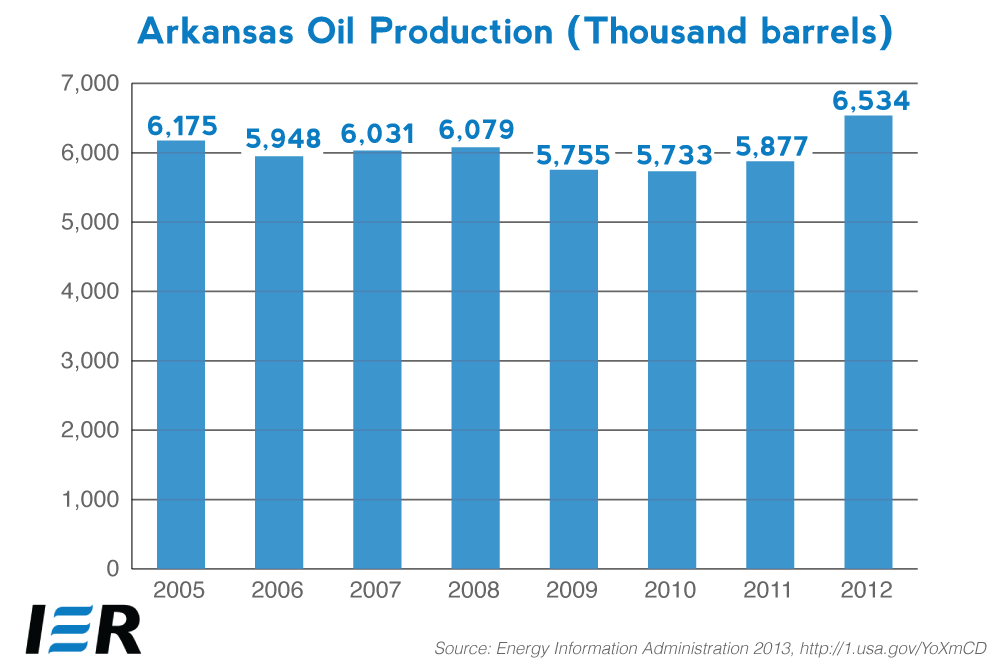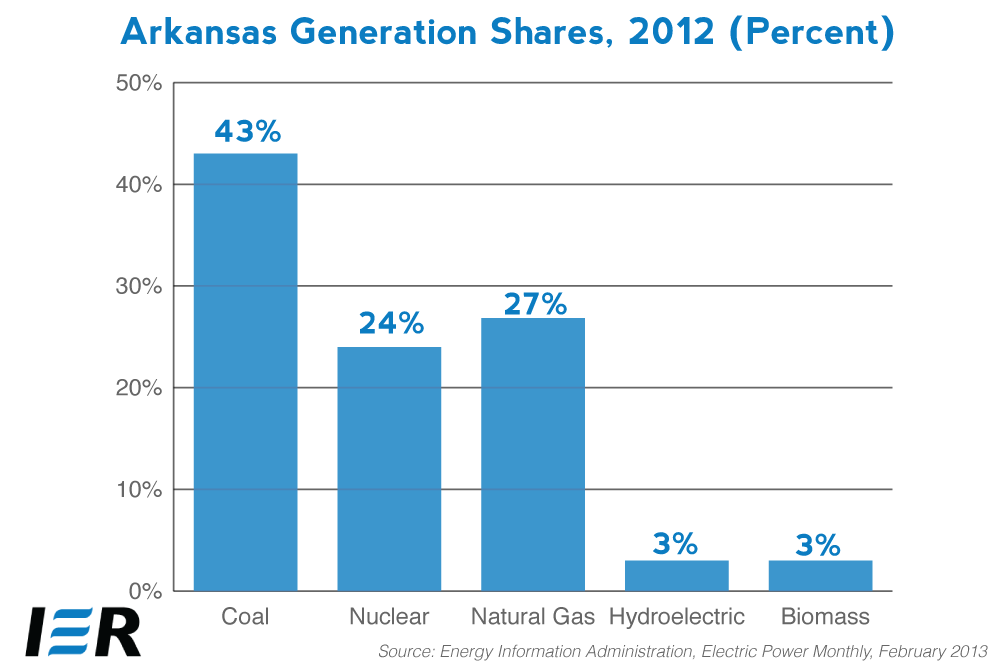Arkansas has some of the lowest energy prices in the country. It has the 7th lowest electricity prices, almost 25 percent lower than the nation’s average electricity price. Its gasoline price is the 12th lowest among the states. It is also a producer of oil and natural gas. Its natural gas production has quadrupled since 2008 due to hydraulic fracturing and its oil production increased over 10 percent in just the last year.
Natural Gas
Natural gas production in Arkansas accounted for almost 5 percent of total U.S. production in 2011, with output of 1.07 trillion cubic feet. Most of the State’s natural gas production takes place in the Arkoma basin, although several wells also operate in the Gulf Coastal Plain. In addition to conventional production, small amounts of natural gas have been extracted from coal bed methane deposits in the Arkoma basin since 2001, with current annual production at 3 billion cubic feet.
Shale gas in the United States is rapidly increasing as a natural gas source. Led by new applications of hydraulic fracturing technology and horizontal drilling, development of shale gas has offset declines in production from conventional gas reservoirs, and has led to major increases in natural gas reserves. In Arkansas, the Mississippian Fayetteville Shale play produces gas in the Arkoma Basin in the western part of the state. The productive section varies in thickness from 50 to 550 feet, and in depth from 1,500 to 6,500 feet. The shale gas was originally produced through vertical wells, but operators are increasingly using horizontal wells in the Fayetteville. Monthly natural gas production in the Fayetteville Basin increased 2,757 percent since January of 2007 due to hydraulic fracturing and horizontal drilling technology.
Source: Energy Information Administration, http://www.eia.gov/naturalgas/weekly/
Several major natural gas pipelines from Texas, Louisiana, and Oklahoma pass through the State on the way to markets in the Midwest and Northeast. The two newest pipelines are the 500-mile Midcontinent Express Pipeline completed in 2009, and the 187-mile Fayetteville Express Pipeline completed in late 2010. The Fayetteville Express Pipeline brings gas from the Fayetteville Shale in Arkansas to pipelines serving the Midwest and Northeast. The 42-inch pipeline originates in Conway County, Arkansas, continues eastward through White County, Arkansas, and terminates at an interconnection with Trunkline Gas Company in Panola County, Mississippi. The pipeline has a capacity of 2.0 billion cubic feet per day.
The Arkansas industrial sector’s natural gas consumption has declined over the past decade. Until 2001, the industrial sector accounted for more than one-half of the State’s natural gas consumption but its share has fallen. In 2011, the industrial sector in Arkansas consumed 32 percent of the state’s total natural gas consumption. The buildings’ (residential and commercial) sector consumed 27 percent and the state’s electric utility sector consumed the largest share—40 percent.
Source: Energy Information Administration, http://www.eia.gov/dnav/ng/ng_prod_sum_dcu_sar_a.htm
Petroleum
Arkansas produced 6.5 million barrels of oil in 2012. The state’s oil production companies extract small amounts of crude oil from stripper wells (wells that produce less than 10 barrels per day) in the southern part of the Gulf Coastal Plain of south Arkansas.
Arkansas has two refineries. The El Dorado refinery processes a crude slate consisting of local Arkansas crudes, West Texas crudes and domestic offshore crudes. With a gathering system of nearly 1,000 miles of pipeline, domestic crudes are delivered to the refinery from southern Arkansas and northern Louisiana mostly from the Smackover field near El Dorado, Arkansas. The refinery has processed various crude oils, including foreign high-sulfur crude, domestic offshore crudes from the Gulf of Mexico, and local onshore domestic crudes.
Petroleum products are delivered to consuming regions by barge via the Arkansas and Mississippi Rivers. The TEPPCO pipeline also supplies petroleum products from Texas and Louisiana. Arkansas is one of the few States that allow the statewide use of conventional motor gasoline, rather than the use of special fuel blends required in non-attainment areas due to air-quality considerations.
Source: Energy Information Administration, http://www.eia.gov/dnav/pet/hist/LeafHandler.ashx?n=pet&s=mcrfpar1&f=a
Coal, Electricity and Renewable Energy
Coal, natural gas, and nuclear power are the dominant energy sources used for electricity generation in Arkansas. Coal-fired power plants accounted for 43 percent of the electricity produced within the State, and the plants rely on coal deliveries from Wyoming. Ranking second, natural gas produced 27 percent of Arkansas’ electricity in 2012
The State’s only nuclear plant, the dual-unit Arkansas Nuclear One Plant in Russellville, typically generates about one-fourth of the total electricity generated in the State. It is a two-unit pressurized water reactor located on Lake Dardanelle. Unit One has a generating capacity of 846 megawatts, and came online in 1974. It is licensed to operate until May 20, 2034.Unit Two has a generating capacity of 930 megawatts, and came online in 1978. It is licensed to operate until July 18, 2038.
Hydroelectric power plants in the White River Basin in the north, along the Arkansas River in central Arkansas, and in the Ouachita River Basin in the south contributed 3 percent to electricity supply in 2012. Along 3 percent of generation in 2012 was produced from biomass.
Source: Energy Information Administration, Electric Power Monthly, February 2013, http://www.eia.gov/electricity/monthly/
Arkansas State Regulatory Environment
Fortunately for the citizens of Arkansas, the state has not imposed many of the regulations that other states have imposed that usually increase the price of energy. Arkansas adopted several policies to encourage renewable energy and energy efficiency including green building standards for State facilities, but it does not mandate the use of renewable energy in electric generation or blended into gasoline, as many states do.
Arkansas requires new residential and commercial buildings to meet energy efficiency standards. New buildings must meet an Arkansas-specific version of the 2003 International Energy Conservation Code that was developed by the International Code Council, and is a model code that mandates certain energy efficiency standards. House Bill 1663, enacted in 2009, directed the Arkansas Energy Office to develop a plan to reduce energy use from 2008 levels in existing state-owned facilities larger than 20,000 square feet, by 20 percent by 2014 and 30 percent by 2017. New state buildings must also be at least ten percent more efficient than ASHRAE 90.1-2007, a model code that mandates certain energy efficiency standards, and is developed by the American Society of Heating and Refrigeration and Air Conditioning Engineers.
In April 2001, Arkansas enacted legislation (HB 2325) directing the Arkansas Public Service Commission (PSC) to establish net-metering rules for certain renewable-energy systems, which were finalized in July 2002. Residential renewable-energy systems up to 25 kilowatts and nonresidential systems up to 300 kilowatts are eligible for net metering. Eligible technologies include solar, wind, hydroelectric, geothermal, biomass, fuel cells and microturbines using renewable fuels.
Legislation enacted in April 2007 (HB 2334) increased the availability of net metering, improved the law’s provision for the carryover of net excess generation to the following monthly bill at the utility’s retail rate, and clarified the ownership of “renewable-energy credits”.
In December of 2010, the Arkansas Public Service Commission announced a Sustainable Energy Resource Action Plan and issued 10 Orders directing the state’s four electric and three natural gas investor-owned utilities to implement energy efficiency measures described in the plan. Order 17 in Docket 08-144-U sets sales reductions targets for both electric and natural gas utilities. The Public Service Commission directed these utilities to file comprehensive energy efficiency plans for 2011, 2012, and 2013 with incremental energy savings that ranged from a 0.25 percent in 2011 compared to a 2010 energy sales to 0.75 percent in 2013 compared to 2010 energy sales for electric utilities and from 0.2 percent in 2011 compared to a 2010 energy sales to 0.4 percent in 2013 compared to a 2010 energy sales for natural gas utilities. At the end of 2013, the cumulative energy savings compared to the 2010 baseline, would be 1.5 percent for the electric utilities and 0.9 percent for the gas utilities.


